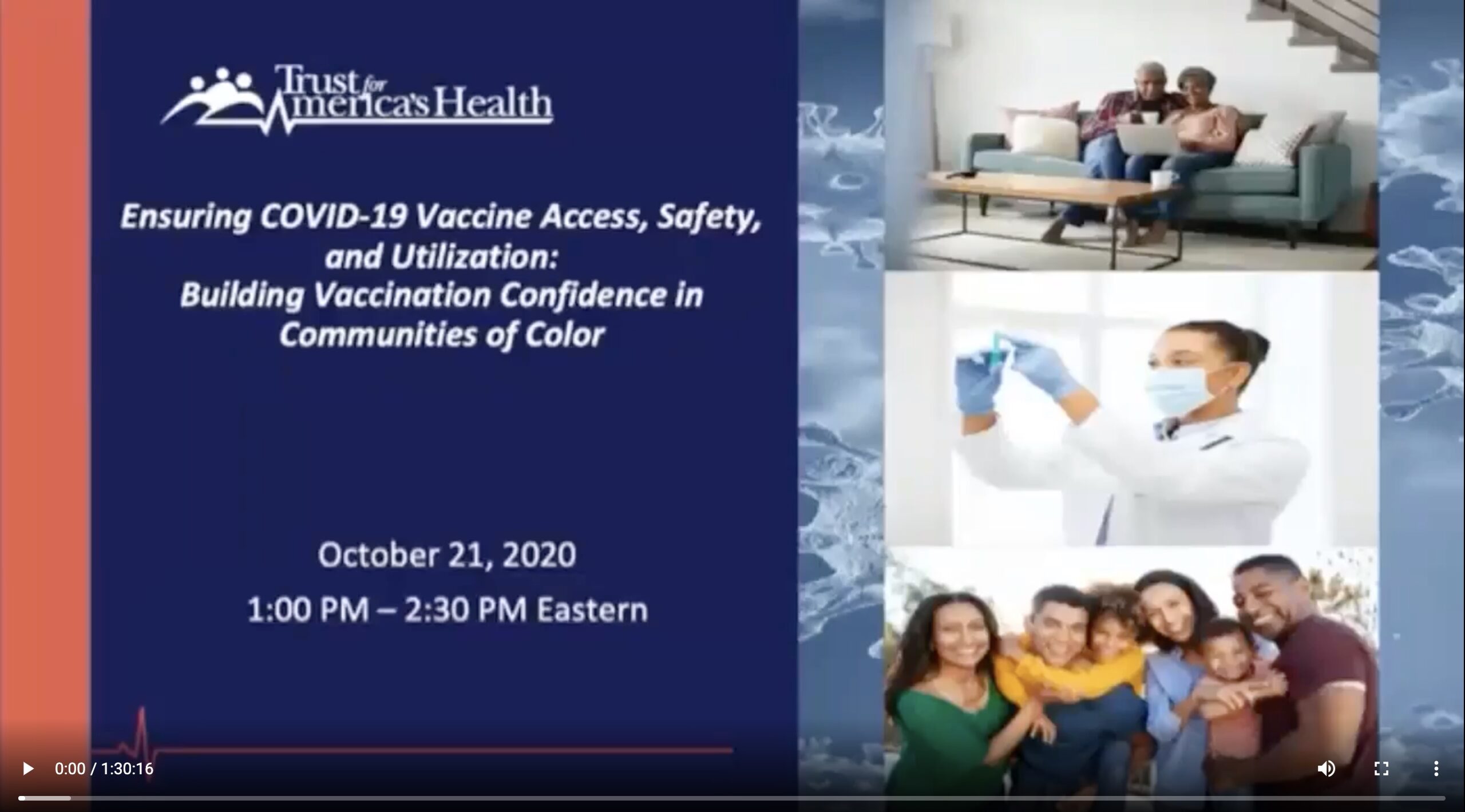Policy brief calls for building vaccine acceptance in communities of color and tribal communities through data transparency, tailored communications via trusted messengers, ensuring ease of vaccine access and no out-of-pocket costs
(Washington, DC – Dec. 21, 2020) – A woeful history of maltreatment of communities of color and tribal nations by government and the health sector, coupled with present day marginalization of these communities by the healthcare system, are the root of vaccine distrust among those groups, according to a policy brief, Building Trust in and Access to a COVID-19 Vaccine Among People of Color and Tribal Nations released today by Trust for America’s Health (TFAH) and co-authors the National Medical Association (NMA) and UnidosUS.
This historic maltreatment, coupled with current day structural racism, has played out in COVID-19’s disproportionate impact on communities of color and tribal communities. These factors also make ensuring vaccine receptivity and access within those communities challenging and of critical importance to protecting lives and ending the pandemic.
In October 2020, TFAH, NMA and UnidosUS hosted a policy convening with 40 leading health equity, healthcare, civil rights, and public health organizations. The purpose of the convening was to advise policymakers on the barriers to vaccine receptivity within communities of color and tribal communities and how to overcome those barriers.
“Earning trust within communities of color and tribal communities will be critical to the successful administration of the COVID-19 vaccine. Doing so will require prioritizing equity, ensuring that leaders from those communities have authentic opportunities to impact vaccine distribution and administration planning, and, the resources to fully participate in supporting vaccine outreach, education and delivery in their communities,” said Dr. J. Nadine Gracia, Executive Vice President and COO of Trust for America’s Health.
The convening created recommendations for policy actions that should be taken immediately within six key areas:
Ensure the scientific fidelity of the vaccine development process.
- HHS and vaccine developers should release all available vaccine data at frequent and regular intervals to improve transparency and increase confidence in the vaccine evaluation process. Leadership at FDA and HHS must commit to advancing any vaccine only after it has been validated based on established federal and scientific protocols. Programs to monitor for adverse events must also be in place and transparent. Any perception of bypassing safety measures or withholding information could derail a successful vaccination effort.
- FDA should engage health and public health professional societies, particularly those representing healthcare providers of color, local public health officials, as well as other stakeholders with a role in vaccination, and allow these groups to validate all available data, review the vaccine development and approval process, and issue regular updates on data to their patients, members, and the public.
Equip trusted community organizations and networks within communities of color and tribal nations to participate in vaccination planning, education, delivery and administration. Ensure their meaningful engagement and participation by providing funding.
- Congress should fund CDC and its state, local, tribal, and territorial partners to provide training, support, and financial resources for community-based organizations to join in vaccination planning and implementation, including community outreach, training of providers, and participation in vaccination clinics. State, local, tribal, and territorial authorities should authentically engage and immediately begin vaccination planning with community-based organizations, community health workers/promotores de salud, faith leaders, educators, civic and tribal leaders, and other trusted organizations outside the clinical healthcare setting as key, funded partners.
Provide communities the information they need to understand the vaccine, make informed decisions, and deliver messages through trusted messengers and pathways.
- Congress should provide at least $500 million to CDC for outreach, communication, and educational efforts to reach priority populations in order to increase vaccine confidence and combat misinformation. All communications must be culturally and linguistically appropriate and tailored as much as possible to reach diverse populations as well as generations within groups.
- FDA and CDC should initiate early engagement with diverse national organizations and provide funding and guidance for state, local, tribal, and territorial planners to help shape messaging and engage locally with healthcare providers in communities of color and tribal communities, such as nurses, pharmacists, promotores de salud, community health workers, and others to ensure they have the information they need to feel comfortable recommending the vaccine to their patients. Congress and HHS should provide funding for training and engagement of trusted non-healthcare communicators to help shape messaging and to train informal networks, civic and lay leaders, and other trusted community leaders and community-based organizations to answer questions and encourage vaccination.
- All messaging about the vaccine must be appropriate for all levels of health literacy. Communication should be realistic and clear about timelines and priority groups (and the rationale for these decisions), vaccine effectiveness, types of vaccines, the number of doses, costs, and the need for ongoing public health protections. Planners must provide information that meets people where they are (e.g., barber shops, bodegas, grocery stores, places of worship, etc.) and ensure that trusted messengers in those places have the information they need to be credible and authentic spokespeople.
Ensure that it is as easy as possible for people to be vaccinated. Vaccines must be delivered in community settings that are trusted, safe and accessible.
- We urge the administration and Congress to appropriate the resources necessary to expand and strengthen federal, state, local, territorial, and tribal capacity for a timely, comprehensive, and equitable COVID-19 vaccination planning, communications, distribution, and administration campaign, including funding to support vaccine distribution at the local level and by community-based organizations.
- Congress and HHS should allocate funding to increase access to vaccination services to ensure that people seeking to be vaccinated do not experience undue increased exposure to the virus as they travel to, move through, and return home from vaccination sites. Flexibility in funding is needed to enable transport of people to vaccination sites, increase accessibility to people without cars, and promote safety and minimize exposure at vaccination locations. Funding should also be provided to health and community-based agencies to assist those for whom transportation or childcare costs are an obstacle to receipt of the vaccine.
- Planners should ensure that vaccination sites are located in areas that have borne a disproportionate burden of COVID-19, especially leveraging community-based organizations such as Federally Qualified Health Centers, community health centers, rural health centers, schools and places of worship. Mobile services will be particularly important in rural areas. Planners should prioritize congregate living facilities, such as long-term care, prisons, and homeless shelters. In addition, some families, displaced by the COVID economic fallout, may be living with relatives. Planners should ensure vaccination sites have services that meet the Americans with Disabilities Act (ADA) and HHS Office for Civil Rights (OCR) standards for disability and language access.
- Federal state, local, tribal, and territorial officials must guarantee and communicate with the public that immigration status is not a factor in people’s ability to receive the vaccine and that immigration status is not collected or reported by vaccination sites/providers. Similarly, the presence of law enforcement officers or military personnel could be a deterrent for vaccination at locations, so planners should consider other means of securing sites.
- In the initial phase, as communities vaccinate healthcare workers, planners must be sure to prioritize home health, long-term care, and other non-hospital-based healthcare workers, who are more likely to be people of color. Other essential workers that comprise large numbers of workers who are people of color and should be treated as within the vaccination priority groups are the food service industry, farmworkers and public transportation employees.
Ensure complete coverage of the costs associated with the vaccine incurred by individuals, providers of the vaccine, and state/local/tribal/territorial governments responsible for administering the vaccine and communicating with their communities about it.
- Congress, the Centers for Medicare and Medicaid Services, and private payers must guarantee that people receiving the vaccine have zero out-of-pocket costs for the vaccine, related health care visits, or any adverse events related to the vaccine, regardless of their health insurance status.
- HHS, with emergency funding from Congress, should provide funding so that state, local, tribal, and territorial governments do not bear any cost of vaccine communication efforts, working with their communities, organizing sites, training their staff, and providing personal protective equipment (PPE).
Congress must provide additional funding and require disaggregated data collection and reporting by age, race, ethnicity, gender identity, primary language, disability status, and other demographic factors on vaccine trust and acceptance, access, vaccination rates, adverse experiences, and ongoing health outcomes.
- CDC, and state, local, tribal, and territorial authorities should include leaders from communities of color and tribal communities and to plan on-going data collection on vaccination efforts, interpret data, add cultural context, share data with communities, and determine implications and next steps.
- CDC, and state, local, tribal, and territorial authorities should use these data to inform ongoing prioritization of vaccine distribution and rapidly address gaps in vaccination that may arise among subpopulations by race, ethnicity, neighborhood, or housing setting.
# # #
Trust for America’s Health is a nonprofit, nonpartisan organization that promotes optimal health for every person and community and makes the prevention of illness and injury a national priority. Twitter: @healthyamerica1



